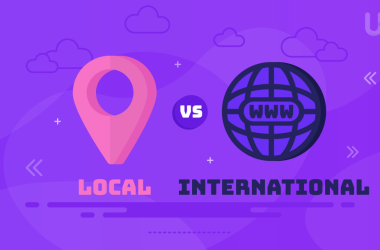Understanding what subdomains are can greatly improve how you administer and structure your website. A subdomain, such as blog.example.com, is basically an annex to the main site that lets you have a structure dedicated to certain purposes without needing a new domain.
This post will cover what is a subdomain, how they benefit your online presence, and give practical examples of how they’re used. We will also look into their role in securing subdomains and how SSL certificates can significantly enhance the functioning of your website, user experience, and even blogging and campaign-related targeted activities.
Understanding Subdomains
A subdomain can be seen as an extension of the main website. It helps separate categorically different portions or functions of the site without creating an entirely new domain. If your main website were a house, subdomains would represent several rooms, each with its function.
For a subdomain example, your main website may be www.example.com, and then you can have a subdomain to hold a blog; you would name that subdomain blog.example.com. This way, visitors can easily find and navigate to your blog while staying within the same overall website structure. It’s a neat way to keep things tidy and organized online.
How It Can Benefit You
Most noticeably, subdomains are useful in improving the user experience with a website because visitors can easily pass through and go directly to the exact content they seek.
Putting e-commerce stores or blogs on separate subdomains, such as store.example.com and blog.example.com, will help to concentrate each area of your site, making it easier to navigate. Moreover, indexing of subdomains happens in some separate way by search engines, which really could develop the general SEO performance of your site.
Find A Domain For Your Website And Give It A Boost!
Looking for a reliable and secure domain provider? With UltaHost’s friendly and transparent pricing structure from the outset,and with no hidden charges, you can get the best deal for the domain of your website.
Cost-Efficiency
Here comes some good news if you wonder about the cost: you can often get a free subdomain. Many hosting providers and domain name registrars allow such a thing, so it is good if you are just starting and want to try without an extra expense.
For example, WordPress.com, Blogger, and other platforms offer users free sub-domains. You could arrange a site with a subdomain like your site.wordpress.com, not needing to spend money on some other domain name. This is an inexpensive way to establish some visibility on the internet.
Organizing Blogs with Subdomains
Subdomains are highly required by blogs. If you are writing any type of blog, whether it is a travel blog or fitness blog, its usage of subdomain will help to maintain the blog independent of your main site, but that is for the purpose of organization. For example, for the subdomain of a blog, like blog.example.com, it would make it quite clear that the area is used specifically for blogs.
A subdomain for a blog would make the process of finding or remembering your blog easier for your target audience. Using a subdomain for a blog essentially allows the tracking of it to happen independently from one’s leading site, which is very useful for both analytics and marketing purposes.
Business Applications of Subdomains

A subdomain in the business world is support.example.com for a company’s customer service portal. Such a subdomain could be used to host resources such as FAQs, live chat options, and help articles so that one can get help.
The other most commonly seen example is shop.example.com for an e-commerce section. Each subdomain does its respective job, making the user experience neat and clean. It also keeps the front page focused on performing the basic functionality it should be serving.
Importance of SSL Certificates
If there is one aspect to consider in the setting of a subdomain, it would be security. And by security, an SSL certificate is in need. The SSL encrypts the transferred data between your website and its visitors, ensuring data privacy and data security. Henceforth, this will take charge of covering sensitive information. One can use a different SSL certificate for each subdomain, or there is the option to look for an SSL certificate that is wildcard and covers the essential domain with all its subdomains.
This is because a wildcard SSL certificate for *.example.com ensures security both for the root domain and other subdomains under it, like blog.example.com or shop.example.com. Such extra added protection gives a more significant level of confidence to your visitors since they are sure that their information will be safe.
Tip: Always use the SSL Checker Tool that enables you to confirm the validity of an SSL certificate of any website.
Easy Management of Subdomains
Managing subdomains does sound tricky, but usually, it’s pretty easy. Most domain registrars and hosting providers have an easy-to-use control panel where you create and manage subdomains with a few clicks. You will only need to put in the name of the subdomain you would like to create and point it towards the correct directory or dedicated IP address on your server.
At this point, in just a few minutes, you could have a new subdomain ready for use. This allows expanding a website flexibly and efficiently with none of the inconveniences of creation and configuration involved with multiple domain names.
Targeting Different Audiences
One of the most beautiful advantages of using subdomains is that a company facilitates the opportunity to target a different audience with utmost ease. For example, there can be a subdomain that deals with another language or region, such as en.example.com for English or es.example.com for Spanish users.
This way, you will be able to subserve your content and services to the demands of different demographic members and make it critical to reach out to a broader range of users. Localizing your subdomains makes it easier for users to engage with your site from a localized and personalized perspective.
Subdomains for Campaigns and Projects
Next to localization, subdomains are also good for campaigns or temporary projects. So, if you’re running some special event or a promotional campaign, let’s say you could create the subdomain event.example.com for the occasion.
Such a subdomain is a repository of the information, registration, and updated forms of the event that are currently relevant. It’s very simple to turn off such a subdomain or even reuse it once this very campaign is completed. This is so you can treat your subdomains like the valuable tools that they are when working with dynamic website strategies.
SEO and Subdomains
One technicality to watch out for when using subdomains is the way they interact with SEO relative to your main domain. Although search engines do consider subdomains to be independent entities because many users utilize stand-alone SEO servers, if used correctly, they inherit the authority of your main domain.
Making sure that you interlink between your subdomain and your main domain can help link equity bleed over, thus increasing the exposure for both the subdomain and the main site. This could raise your overall search engine performance, providing users with an easier ability to find your online content.
Testing New Features with Subdomains
You can test new properties or services before implementing them on the flagship site on hosting services. A subdomain like beta.example.com can be used to test new designs, functionalities, or products so you can get user feedback and make the required changes without impacting the performance and user experience on your leading site.
Finally, once you are confident in the new feature, you can merge it into the main site seamlessly. This approach mitigates risks and provides a much smoother transition for your users.
Conclusion
Subdomains are versatile and potent in segregating the many sections of your site. They help keep the site organized, create an improved user experience, and boost SEO efforts at significant events. Whether you install a blog, run a particular campaign, or just want to target your traffic to a specific audience, subdomains offer unexpected flexibility in a cost-effective manner.
The security of SSL certificates can also be ensured to ensure that the subdomains are accessible and comfortable for website visitors. So, whether you’re a seasoned webmaster or just starting, consider how subdomains could add to your online presence.
Want to see the back record of your website? Use UltaHost’s Domain DNS Lookup Tool to quickly verify DNS configuration, check DNS records, IP address, and how a website connects online. It is fast, reliable and secure!
FAQ
What is a subdomain, and how is it used?
A subdomain may be thought of as almost an extension to the primary domain in which it operates independently, much like a sub-section of your website, for example, blog.example.com.
How will subdomains benefit my website?
Subdomains have many benefits associated with user experience by content organization, improved SEO performance, and opportunities for running targeted campaigns or localization toward various audiences.
Can I get a free subdomain?
Yes, most web hosting services and platforms, such as WordPress.com, offer free subdomains. This need not come with extra costs just to get things rolling.
Why should you use a subdomain for your blog?
Using a subdomain for your blog keeps the content organized and makes it easy to locate for visitors. It also aids in tracking performance independently of your leading site.
Do subdomains need an SSL certificate?
Securing your subdomains with an SSL certificate is imperative for data safety and gaining confidence from visitors.








